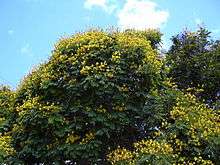Peltophorum pterocarpum
| Peltophorum pterocarpum | |
|---|---|
 | |
| Scientific classification | |
| Kingdom: | Plantae |
| (unranked): | Angiosperms |
| (unranked): | Eudicots |
| (unranked): | Rosids |
| Order: | Fabales |
| Family: | Fabaceae |
| Genus: | Peltophorum |
| Species: | P. pterocarpum |
| Binomial name | |
| Peltophorum pterocarpum (DC.) K.Heyne | |
| Synonyms[1] | |
| |
Peltophorum pterocarpum (commonly known as copperpod, yellow-flamboyant, yellow flametree, yellow poinciana or yellow-flame)[2] is a species of Peltophorum, native to tropical southeastern Asia and a popular ornamental tree grown around the world.
Description
It is a deciduous tree growing to 15–25 m (rarely up to 50 m) tall, with a trunk diameter of up to 1 m belonging to Family Leguminosae and sub-family Caesalpiniaceaea. The leaves are bipinnate, 30–60 cm long, with 16-20 pinnae, each pinna with 20-40 oval leaflets 8–25 mm long and 4–10 mm broad. The flowers are yellow, 2.5–4 cm diameter, produced in large compound racemes up to 20 cm long.
The fruit is a pod 5–10 cm long and 2.5 cm broad, red at first, ripening black, and containing one to four seeds. Trees begin to flower after about four years.[3][4]
Distribution
Peltophorum pterocarpum is native to tropical southeast Asia and northern Australasia, in: Australia (including islands off the Northern Territory coast),[2][3] Sri Lanka, Indonesia, Malaysia, Papua New Guinea, Thailand and Vietnam (where it is called Lim xẹt).
Uses
The tree is widely grown in tropical regions as an ornamental tree, particularly in India, Nigeria, Pakistan, and Florida and Hawaii in the United States. The trees have been planted alternately in India as a common scheme for avenue trees in India alternately with Delonix regia (Poinciana) to give a striking yellow and red effect in summer, as has been done on Hughes road in Mumbai.[5]
The wood has a wide variety of uses, including cabinet-making[6] and the foliage is used as a fodder crop.[3] The brownish colour called sogan typical of batik cloth from inland Java is produced from P. pterocarpum, which is known there as soga.[7]
References
- ↑ "Peltophorum pterocarpum". International Legume Database & Information Service (ILDIS). Retrieved 30 Aug 2016 – via The Plant List.
- 1 2 "Peltophorum pterocarpum (DC.) K.Heyne". Germplasm Resources Information Network (GRIN). Agricultural Research Service (ARS), United States Department of Agriculture (USDA). Retrieved 30 Aug 2016.
- 1 2 3 World AgroForestry Centre: Peltophorum pterocarpum
- ↑ Huxley, A., ed. (1992). New RHS Dictionary of Gardening. Macmillan ISBN 0-333-47494-5.
- ↑ Blatter, Ethelbert; Millard, Walter Samuel (1977) [1937]. Some beautiful Indian Trees (2 ed.). Mumbai: Bombay natural History Society. pp. 109–111.
- ↑ McCann, Charles. (1966). 100 Beautiful Trees of India. (3/ed) Taraporevala, Mumbai. Pg 259.
- ↑ Widianto, Eko (14 April 2014). "Malang Exhibits Royal Batik from Various Regions". Tempo. Retrieved 30 August 2016.
| Wikimedia Commons has media related to Peltophorum pterocarpum. |
